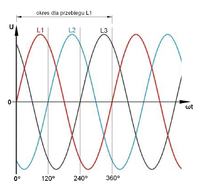Hello, perhaps a trivial question, but what does a phase shift of 1/3 period mean?
I`m a layman in this topic, but I understand it like this:
The current has a frequency of 50Hz, if I understand correctly, this refers to voltage changes, and 50Hz means 50 voltage increases and decreases per second, so the period is 0.02 seconds.
Does this mean that changes in individual phases have the same frequency, but are not synchronized, but shifted in time by 0.02/3 seconds?
I`m a layman in this topic, but I understand it like this:
The current has a frequency of 50Hz, if I understand correctly, this refers to voltage changes, and 50Hz means 50 voltage increases and decreases per second, so the period is 0.02 seconds.
Does this mean that changes in individual phases have the same frequency, but are not synchronized, but shifted in time by 0.02/3 seconds?



